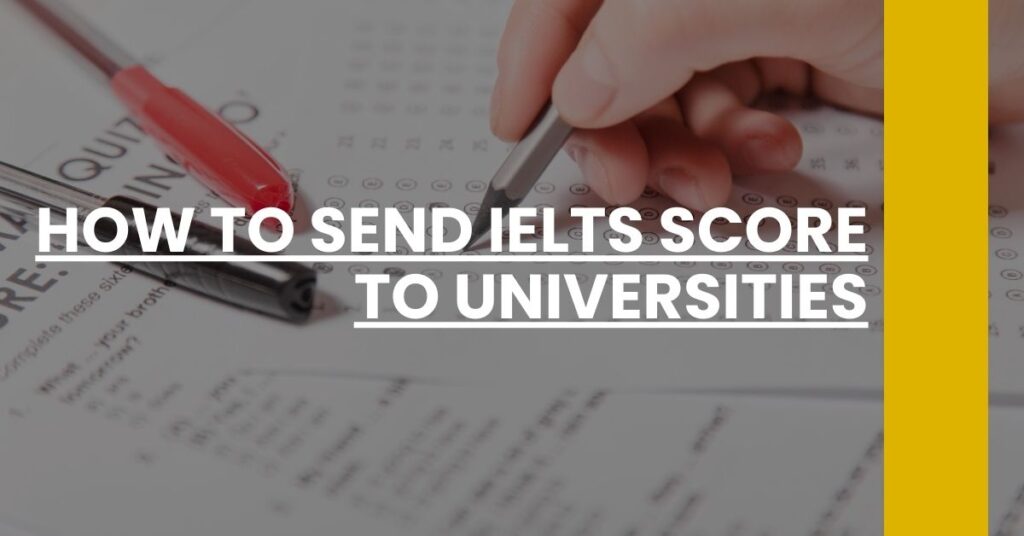Learn how to send IELTS scores to universities with ease and confidence.
- Online Submission Guide: Step-by-step instructions for the electronic dispatch of IELTS results.
- University Preferences: Understanding the specific IELTS score requirements of different institutions.
- Avoiding Common Errors: Tips to ensure your score reaches its destination without a hitch.
Navigate the nuances of sending your IELTS score to top universities.
- Understanding the IELTS Score Sending Process
- IELTS Test Centers and Score Reporting
- Electronic Versus Paper Score Delivery: Which to Choose?
- Choosing the Right Universities for Your IELTS Scores
- Fees and Charges for Sending IELTS Scores
- Timing Your Score Submission
- Reporting IELTS Scores to US Universities: Specifics
- Common Issues and How to Resolve Them
- Checking That Universities Have Received Your Scores
- Conclusion: Finalizing Your University Applications with IELTS Scores
Understanding the IELTS Score Sending Process
Navigating the journey of sending your IELTS scores to universities might seem daunting, but it’s actually a streamlined process designed to make your application experience as seamless as possible. Your scores serve as a testament to your English language proficiency and are a key component of your university application.
What Happens After the Test?
Once you have taken the IELTS test, your results, also known as the Test Report Form (TRF), will be available after 13 days for the paper-based test and 3-5 days for the computer-based test. You are entitled to one personal copy that will be sent to you via mail, but when it comes to universities, the British Council or IDP can send out additional TRFs directly to the institutions you’re applying to.
Paper vs. Electronic Score Delivery
- Understanding the Options: The IELTS score can be delivered to universities in two formats: a traditional paper report or an electronic submission. While the paper form is a physical copy of your TRF, the electronic submission is a secure and quicker method of transmitting your results to the institutions.
- Which Universities Accept Electronic Scores? Before choosing your delivery method, confirm with your prospective universities whether they accept electronic scores, as not all institutions may be set up to receive them.
Authorization and Recipient Institutions
Give consent for your scores to be sent to universities when you register for the IELTS or shortly after your test via the test center or your online test-taker portal. You can typically choose up to five recipient institutions to which the test center will send your scores for free.
IELTS Results Service E-Delivery
For a more efficient process, take advantage of the IELTS Results Service E-Delivery system. This system securely sends electronic score data directly to participating organizations. You can confirm participation by asking the university admissions office or checking their website for instructions on receiving IELTS scores.
IELTS Test Centers and Score Reporting
Your IELTS test center is not just a venue for taking the test but also your ally in ensuring your score reaches the universities of your choice. Whether you’ve taken the test with the British Council or IDP, you’ll need to keep a few key things in mind:
Requesting Additional TRFs from the Test Center
If you need to send your scores to more than five organizations or missed adding a recipient initially, you may request additional TRFs from the test center. Be aware that there might be a fee for each additional report.
Handling Delays and Corrections
When dealing with score reporting, act with dispatch and attention to detail. If you spot an error or if there’s been a delay, contact your test center promptly. They are equipped to assist you and provide guidance on resolving any issues that may arise.
Electronic Versus Paper Score Delivery: Which to Choose?
Deciding between electronic and paper delivery of your IELTS scores largely depends on your destination universities’ requirements and your own convenience. Let’s break it down:
Electronic Delivery
- Speed: Scores reach universities faster, sometimes within minutes.
- Security: Electronic scores are less susceptible to loss or damage.
- Ease of Verification: Many universities can authenticate your scores directly through the system.
Paper Delivery
- Tangibility: Some find comfort in having a physical document.
- Universality: Accepted by all institutions, regardless of their digital capabilities.
What Should You Choose?
Ultimately, your choice should align with the university’s acceptance policy and your personal preferences. Confirm with each institution to ensure you’re fulfilling their requirements and then proceed with the option that offers peace of mind and convenience.
Choosing the Right Universities for Your IELTS Scores
This stage of your application process demands selectivity and precision—you want to send your IELTS scores to universities that match your academic aspirations and your language proficiency level.
Research and Requirements
Begin by thoroughly researching each university’s IELTS score requirements. Universities typically list the minimum scores accepted for each program on their admissions pages. Understanding these requirements is fundamental in setting realistic goals and choosing universities where you’ll be a competitive candidate.
Aligning Your Scores with University Expectations
- Aim High: It’s advantageous to target universities where your scores are above the minimum requirement, enhancing your chance of acceptance.
- Understand Variations: Some universities have different score requirements for various programs or departments. Be meticulous when reviewing these details.
Building a Balanced University List
Create a balanced list of universities to send your scores to, much like you would strategize for college applications in general. Include a mix of “ambitious,” “target,” and “safe” options, facilitating a spread of opportunities based on your scores.
Transparency and Communication
Being transparent about your IELTS score when inquiring with universities is important. If your score is near the threshold, ask if additional language support or courses are available. Communication with the admissions office can sometimes open doors or clarify any uncertainties regarding language requirements.
Remember, your IELTS scores are a tool to paint a picture of your linguistic capabilities. Use them wisely, pushing forward to academic institutions that not only recognize your potential but also resonate with your academic journey.
Fees and Charges for Sending IELTS Scores
Sending your IELTS scores to universities is a crucial step in fulfilling your application requirements. While multiple score reports can be sent to institutions, it’s important to understand that some fees may apply.
Standard Submission: The Free Range
Initially, you can send your IELTS scores to up to five institutions without any cost. This free service is included in your test fee, which is convenient and helpful for budget-conscious applicants.
Above and Beyond: Additional Reports
When you need to send scores to more than five universities or after the one-month deadline post your test date, fees come into play. Here’s what you should expect:
- Additional TRFs: Each additional TRF may have a charge that varies by test center and country.
- Speed Matters: If you require expedited delivery, such as courier service, be prepared for higher charges.
Always check with the official IELTS fees for the most up-to-date pricing information.
Keep an Eye on Currency
Fees are usually quoted in the local currency of the test center, so if you’re sending scores internationally, factor in the conversion rates and possible bank fees for a more accurate financial plan.
Payment Procedures
- How to Pay: Payment methods vary by test center but typically include credit cards, bank transfers, or in-person payments at the test center.
- Receipts and Records: Always request a receipt for your transaction to keep detailed records of your payments in case any questions arise.
Timing Your Score Submission
Precision and punctuality are key when submitting your IELTS scores. Here’s how to ensure your universities receive your scores in good time:
The Life Span of Your Scores
IELTS scores are valid for two years. Be mindful of this while planning applications to ensure that your scores will not expire before the admission process or your intended start date.
Aligning with Admission Deadlines
- Early Bird Gets the Worm: Aim to send your scores well before the application deadline. This accounts for any processing times or unexpected delays.
- Confirmation Crunch: Keep in mind that universities also need time to process incoming scores and match them to your application.
Pro-Tip: Tracking and Communication
After sending your scores:
- Track the delivery status if possible, especially for paper reports.
- Communicate with the admissions office to confirm receipt of your IELTS scores.
This proactive approach helps avoid any hiccups in your application process due to missing or unprocessed scores.
Reporting IELTS Scores to US Universities: Specifics
The United States has its unique nuances when it comes to sending IELTS scores. Here’s what you should know as an applicant:
Identification Codes
Each US university may have a specific code used to identify IELTS score reports. Make sure you have the correct code from your target institution to ensure proper routing of your scores.
Know the System
- Undergraduate Admissions: U.S. undergraduate programs may use centralized application services that require a different approach for sending IELTS scores. Confirm with the application service or university for specific instructions.
- Graduate and Professional Programs: For graduate programs, you usually send scores directly to the institutions unless otherwise specified.
Double-Check the Address and Contact Details
Documentation should be free of errors, especially when sending to large campuses where misrouting can occur. Keep the destination department in your communications precise.
Common Issues and How to Resolve Them
Nothing disrupts your application process like a snag in score reporting. Let’s explore common issues and ways to troubleshoot:
Issues with the Details
- Typos Can Trip You Up: Double-check every detail you submit for score sending, including institution codes and departmental addresses.
- Keep Proof Handy: Retain copies of your TRF and any correspondence you have with the test center or universities in case you need to verify information.
Delays and Miscommunications
- Anticipate Hold-Ups: During peak application periods, delays are common. Start the process early and follow up as needed.
- Clear the Air: If there are delivery issues or if you notice an error, promptly contact the test center. They are there to facilitate corrections and provide solutions.
Checking That Universities Have Received Your Scores
Ultimately, your target is to have the universities receive and process your IELTS scores. Here’s a checklist for peace of mind:
Direct Follow-Up
- Contact Admissions: About two weeks after sending your scores, reach out to the admissions office to confirm they have been received.
- Leverage Technology: Use online applicant portals provided by many universities to track the status of your documents, including your IELTS scores.
In Case of a Mix-Up
If there is a discrepancy:
- Contact the test center to confirm dispatch details.
- Get in touch with the admissions office with your tracking information and inquire about next steps.
With clear channels of communication, such discrepancies can be swiftly resolved.
Conclusion: Finalizing Your University Applications with IELTS Scores
Sailing through the IELTS score submission process is the linchpin in securing your place at your chosen university. Crisp, concise, and persistent efforts will ensure your scores highlight your application, evidencing your language capability. Let this journey be hallmarking your readiness for international academia, where your scores stride ahead, unlocking doors to your future. No closing summary needed, really – just send your scores accurately and on time to push forward, turning your university dreams into reality.
Learn how to send IELTS scores to universities efficiently with our step-by-step guide, ensuring your application is complete.

